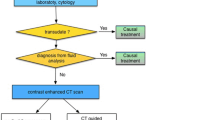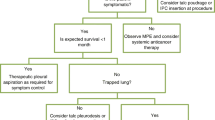Opinion statement
Malignant pleural effusions contribute to considerable morbidity in cancer patients and generally portend an overall poor prognosis. Treatment of malignant pleural effusions is palliative; therefore, quality of life issues, as well as the risks and benefits of the therapeutic options, become more critical. In my opinion, factors such as in patient versus outpatient management and associated procedural discomfort are important in the decision-making process, and the patient should participate in these subjective con-siderations. It is difficult to compare results and determine the true efficacy of different techniques and agents because endpoints and response criteria as well as the extent and method of follow-up vary. In addition, the etiology of the primary complaint, dyspnea, is frequently multifactorial. However, malignant effusions recur, and therefore repeated thoracentesis, especially if the fluid rapidly reaccumulates, is usually not a good long-term solution unless the patient’s overall prognosis and current condition prohibits a more invasive option. The standard option for recurrent effusions is insertion of a chest tube. If the lung re-expands, chemical pleurodesis is attempted to achieve adherence of the visceral to the parietal pleura. Sterilized talc is the best sclerosant; it has good efficacy and cost effectiveness and can be administered easily as a slurry at the bedside via a chest tube with minimal patient discomfort and without more aggressive and invasive procedures.
Similar content being viewed by others
References and Recommended Reading
Belani CP, Pajeau TS, Bennett CL: Treating malignant pleural effusions cost consciously. Chest 1998, 113:78s-85s. Discusses concerns regarding the cost of therapy.
Rousseau P: Malignant pleural effusions: a brief synopsis. Am J Hospice Palliative Care 1997, 4:302–304.
Martinez JG, Little AG, Ferguson MK: Malignant pleural effusion. Postgrad General Surg 1989, 1:75–80.
Grossi F, Pennucci MC, Tixi L, et al.: Management of malignant pleural effusions. Drugs 1998, 55:47–58. A good review of the options with emphasis on various sclerosants.
Zimmer PW, Hill M, Casey K, et al.: Prospective randomized trial of talc slurry vs bleomycin in pleurodesis for symptomatic malignant pleural effusions. Chest 1997, 112:430–114.
Yim APC, Chan ATC, Lee TW, et al.: Thoracoscopic talc insufflation versus talc slurry for symptomatic malignant pleural effusion. Ann Thorac Surg 1996, 62:1655–1658.
Robinson RD, Fullerton DA, Albert JD, et al.: Use of pleural Tenckhoff catheter to palliate malignant pleural effusion. Ann Thorac Surg 1994, 57:286–288.
Ponn RB, Blancaflor J, D’Agostino RS, et al.:Pleuroperitoneal shunting for intractable pleural effusions. Ann Thorac Surg 1991, 51:605–609.
Rodriguez-Panadero F: Current trends in pleurodesis. Curr Opin Pulm Med 1997, 3:319–325.
Author information
Authors and Affiliations
Rights and permissions
About this article
Cite this article
Reeder, L.B. Malignant pleural effusions. Curr. Treat. Options in Oncol. 2, 93–96 (2001). https://doi.org/10.1007/s11864-001-0020-x
Issue Date:
DOI: https://doi.org/10.1007/s11864-001-0020-x




